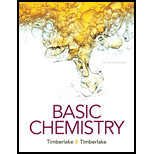
Concept explainers
(a)
Interpretation:
The balanced and complete chemical equation for the given reaction should be determined.
Concept Introduction:
Chemical equation is written in such a way that the symbolic representation of reaction represents the reaction taking place in the system. The reactants are written on the left-hand side and the products are written on the right-hand side of the equation and are separated by an arrow, two or more reactants and products are separated by “+”. The reactions for those the number of atoms of each element in the reactant and in the product, side are equal, such reactions are said to be a balanced chemical equation.
(b)
Interpretation:
The balanced and complete chemical equation for the given reaction should be determined.
Concept Introduction:
Chemical equation is written in such a way that the symbolic representation of reaction represents the reaction taking place in the system. The reactants are written on the left-hand side and the products are written on the right-hand side of the equation and are separated by an arrow, two or more reactants and products are separated by “+”. The reactions for those the number of atoms of each element in the reactant and in the product, side are equal, such reactions are said to be a balanced chemical equation.
Want to see the full answer?
Check out a sample textbook solution
Chapter 17 Solutions
Basic Chemistry (5th Edition)
 ChemistryChemistryISBN:9781305957404Author:Steven S. Zumdahl, Susan A. Zumdahl, Donald J. DeCostePublisher:Cengage Learning
ChemistryChemistryISBN:9781305957404Author:Steven S. Zumdahl, Susan A. Zumdahl, Donald J. DeCostePublisher:Cengage Learning ChemistryChemistryISBN:9781259911156Author:Raymond Chang Dr., Jason Overby ProfessorPublisher:McGraw-Hill Education
ChemistryChemistryISBN:9781259911156Author:Raymond Chang Dr., Jason Overby ProfessorPublisher:McGraw-Hill Education Principles of Instrumental AnalysisChemistryISBN:9781305577213Author:Douglas A. Skoog, F. James Holler, Stanley R. CrouchPublisher:Cengage Learning
Principles of Instrumental AnalysisChemistryISBN:9781305577213Author:Douglas A. Skoog, F. James Holler, Stanley R. CrouchPublisher:Cengage Learning Organic ChemistryChemistryISBN:9780078021558Author:Janice Gorzynski Smith Dr.Publisher:McGraw-Hill Education
Organic ChemistryChemistryISBN:9780078021558Author:Janice Gorzynski Smith Dr.Publisher:McGraw-Hill Education Chemistry: Principles and ReactionsChemistryISBN:9781305079373Author:William L. Masterton, Cecile N. HurleyPublisher:Cengage Learning
Chemistry: Principles and ReactionsChemistryISBN:9781305079373Author:William L. Masterton, Cecile N. HurleyPublisher:Cengage Learning Elementary Principles of Chemical Processes, Bind...ChemistryISBN:9781118431221Author:Richard M. Felder, Ronald W. Rousseau, Lisa G. BullardPublisher:WILEY
Elementary Principles of Chemical Processes, Bind...ChemistryISBN:9781118431221Author:Richard M. Felder, Ronald W. Rousseau, Lisa G. BullardPublisher:WILEY





